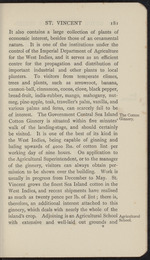| 1 |
 |
“...is a saman tree (Inga saman).
Its branches give footholc^^^^nnumerable plants
(Epiphytes), which live on air, and consequently do
not sap the energy of their host. Orchids which
would be considered rare at home grow in pro-
fusion, and a variety of grasses and lianes hang
from the giant limbs of this monster, which also
affords sanctuary to all sorts of creeping and
crawling things, from the manicou, a kind of
opossum, to the hairy tarantula spider. A clump
of bamboos over 80 feet high cannot fail to
excite remark, and screw-pines (Pandanus), groo-
groo palms (Acrocomia selerocarpa), sand-box trees
(Hura crepitans), cannon-ball trees and banyans,
to say nothing of the more familiar hibiscus,
poinsettias, dracaenas, and crotons of every colour
will astonish those who are new to the tropics.
The gardens contain a well-stocked library and
a fine herbarium, to which visitors interested in
botany are welcomed if they are furnished with...”
|
|
| 2 |
 |
“...institutions under the
control of the Imperial Department of Agriculture
for the West Indies, and it serves as an efficient
centre for the propagation and distribution of
important industrial and other plants to local
planters. To visitors from temperate climes,
trees and plants, such as arrowroot, banana,
cannon-ball, cinnamon, cocoa, clove, black pepper,
bread-fruit, india-rubber, mango, mahogany, nut-
meg, pine-apple, teak, traveller’s palm, vanilla, and
various palms and ferns, can scarcely fail to be
of interest. The Government Central Sea Island The Cotton
Cotton Ginnery is situated within five minutes’Glnnery'
walk of the landing-stage, and should certainly
be visited. It is one of the best of its kind in
the West Indies, being capable of ginning and
baling upwards of 4000 lbs. of cotton lint per
working day of nine hours. On application to
the Agricultural Superintendent, or to the manager
of the ginnery, visitors can always obtain per-
mission to be shown over the building. Work...”
|
|
